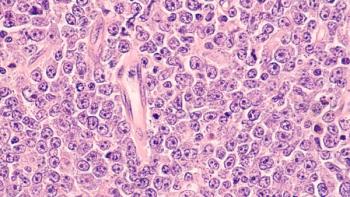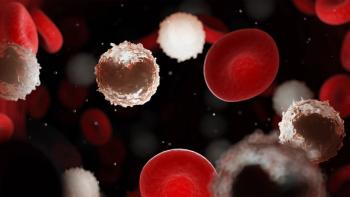
PSA-PFS Improves With Apalutamide Plus ADT in High-Risk Relapsed Prostate Cancer
Patients with castration-sensitive prostate cancer treated with apalutamide plus androgen deprivation therapy experienced improvements in prostate-specific antigen progression-free survival.
Adding apalutamide (Erleada) to androgen deprivation therapy (ADT), either with or without abiraterone acetate (Zytiga), improved prostate-specific antigen (PSA) progression-free survival (PSA-PFS) when compared with ADT alone in the treatment of patients with high-risk biochemically relapsed castration-sensitive prostate cancer, according to recent study results.
These findings led to the phase 3 PRESTO trial (NCT03009981) meeting the prespecified boundary for significance (P <.000632), according to the publication of the results in the Journal of Clinical Oncology.1
At a median follow-up of 21.5 months, the median PSA-PFS was 24.9 months (95% CI, 23.3-32.3) with apalutamide plus ADT (n = 168) vs 20.3 months (95% CI, 18.2-22.9) with ADT alone (n = 166; HR, 0.52; 95% CI, 0.35-0.77; P =.00047). At a median follow-up of 21.3 months, the median PSA-PFS was 26.0 months (95% CI, 22.9-32.5) with apalutamide plus abiraterone acetate and ADT (n = 169) vs 20.0 months (95% CI, 18.2-22.5) with ADT alone (HR, 0.48; 95% CI, 0.32-0.71; P =.00008).
Notably, PSA-PFS was improved in both investigational arms regardless of whether patients had a PSA doubling time of less than 3 months or between 3 and 9 months at baseline.
“Apalutamide plus ADT improved PSA-PFS compared with ADT alone without adversely affecting time to testosterone recovery after completion of a finite duration of treatment. The further addition of abiraterone acetate plus prednisone to apalutamide and ADT did not appear to provide additional benefit with respect to PSA-PFS and was associated with higher frequency of toxicity, particularly rates of hypertension,” study authors wrote.
Fixed-duration ADT is the standard of care for patients with high-risk biochemically relapsed prostate cancer. ADT intensification with next-generation androgen pathway inhibitors has also improved survival in patients with nonmetastatic castration-resistant and metastatic castration-sensitive disease. Prior phase 2 data have also shown the potential for improved biochemical PFS with ADT and apalutamide in patients with biochemically relapsed castration-sensitive disease, serving as the basis for further evaluation of the approach in a phase 3 setting.
To be eligible for enrollment in the open-label study patients had to have histologically confirmed prostate adenocarcinoma with prior radical prostatectomy and adjuvant or salvage radiation, subsequent biochemical recurrence, and a minimum PSA level of 0.5 ng/mL with a doubling time of no more than 9 months at study entry. Notably, metastasis-directed therapy was not allowed.
Patients were randomly assigned 1:1 to ADT alone; ADT plus apalutamide 240 mg once daily; or ADT plus apalutamide, abiraterone acetate 1,000 mg once daily, and prednisone 5 mg once daily.
The primary end point was PSA-PFS, which was defined as serum PSA above 0.2 ng/mL at the end of treatment. Secondary end points included PSA-PFS in the testosterone-recovered population, median time to testosterone recovery, and safety.
A total of 503 patients were enrolled. Baseline characteristics in the overall patient cohort indicated that the median patient age was 66.7 years (range, 61.1-71.0) and most patients were White (83.7%) and non-Hispanic (91.1%). Gleason score at diagnosis was 6 or 7 in 61.0% of patients, 8 in 11.1%, and 9 or 10 in 26.6%; 6 patients had missing data. The median serum PSA at baseline was 1.8 ng/mL (range, 1.0-3.6) and most patients (74.2%) had a PSA doubling time of 3 to 9 months. Median serum testosterone levels were 354.5 (range, 272-461.3) at baseline. The time from radical prostatectomy to study entry was 4.4 years (range, 2.8-6.8). Most patients received prior radiation (84.7%), whereas only 42.3% received prior ADT.
Of the 503 patients who were randomly assigned to treatment, 383 (76.1%) completed the 52-week treatment course; 63 patients (12.5%) remain on therapy. The primary reason for treatment discontinuation was patient withdrawal (5.4%), followed by PSA progression (2.0%), other reason (1.6%), adverse effect ([AE] 1.6%), death (0.4%), receipt of an alternative therapy (0.2%), and emergence of another complicating disease (0.2%).
Additional results indicated that the time to testosterone recovery (>50 ng/dL) after treatment discontinuation was no different in patients who received abiraterone plus ADT and ADT alone (HR, 0.94; 95% CI, 0.68-1.29). A numerically but not statistically significant longer time to testosterone recovery was seen between patients who received abiraterone acetate plus apalutamide and ADT and ADT alone (HR, 0.75; 95% CI, 0.54-1.03).
Regarding safety, over 90% of patients in all arms experienced treatment-emergent AEs (TEAEs), the most common of which included hot flashes (78%), fatigue (55%), injection site reaction (33%), hypertension (31%), insomnia (21%), arthralgias (15%), and hyperglycemia (14%). Hypertension was also the most common grade 3 or greater AE, occurring in 8%, 7%, and 19% of patients who received ADT alone, ADT plus apalutamide, and ADT plus abiraterone acetate and apalutamide.
Serious AEs occurred in 8%, 9%, and 17% of patients in the ADT, ADT plus apalutamide, and ADT plus apalutamide and abiraterone acetate arms, respectively, the most common of which included hypertension (1%), dyspnea (0.6%), and fall (0.6%).
Dose interruptions and/or reductions in the ADT, ADT plus apalutamide, and ADT plus apalutamide and abiraterone acetate arms occurred in 8%, 20%, and 45% of patients, respectively, and discontinuations occurred in only 2% and 3% of patients in the ADT/apalutamide and ADT/apalutamide/abiraterone acetate arms, respectively.
The authors concluded that the combination of apalutamide and ADT should be considered for patients with high-risk biochemically recurrent prostate cancer, adding that patient-reported quality of life data will be presented in a subsequent analysis.
“Intensification of ADT in the biochemically recurrent castration-sensitive disease setting is further supported by the recently reported phase 3 EMBARK study [NCT02319837]. In this study, both ADT plus enzalutamide [Xtandi] as well as enzalutamide monotherapy prolonged metastasis-free survival and PSA-PFS compared with ADT alone. There were important differences in the study population and design of EMBARK, which hinder cross-trial comparisons with the current study. Nevertheless, the aggregate data from both studies bolster the rationale for intensification of androgen blockade, given for a finite treatment interval with planned treatment interruptions, as a potential new standard of care in the high-risk biochemically recurrent setting.”
Reference
Aggarwal R, Heller G, Hillman DW, et al. PRESTO: A phase III, open-label study of intensification of androgen blockade in patients with high-risk biochemically relapsed castration-sensitive prostate cancer (AFT-19). J Clin Oncol. Published online January 23, 2024. doi:10.1200/JCO.23.01157
Newsletter
Knowledge is power. Don’t miss the most recent breakthroughs in cancer care.
















































































